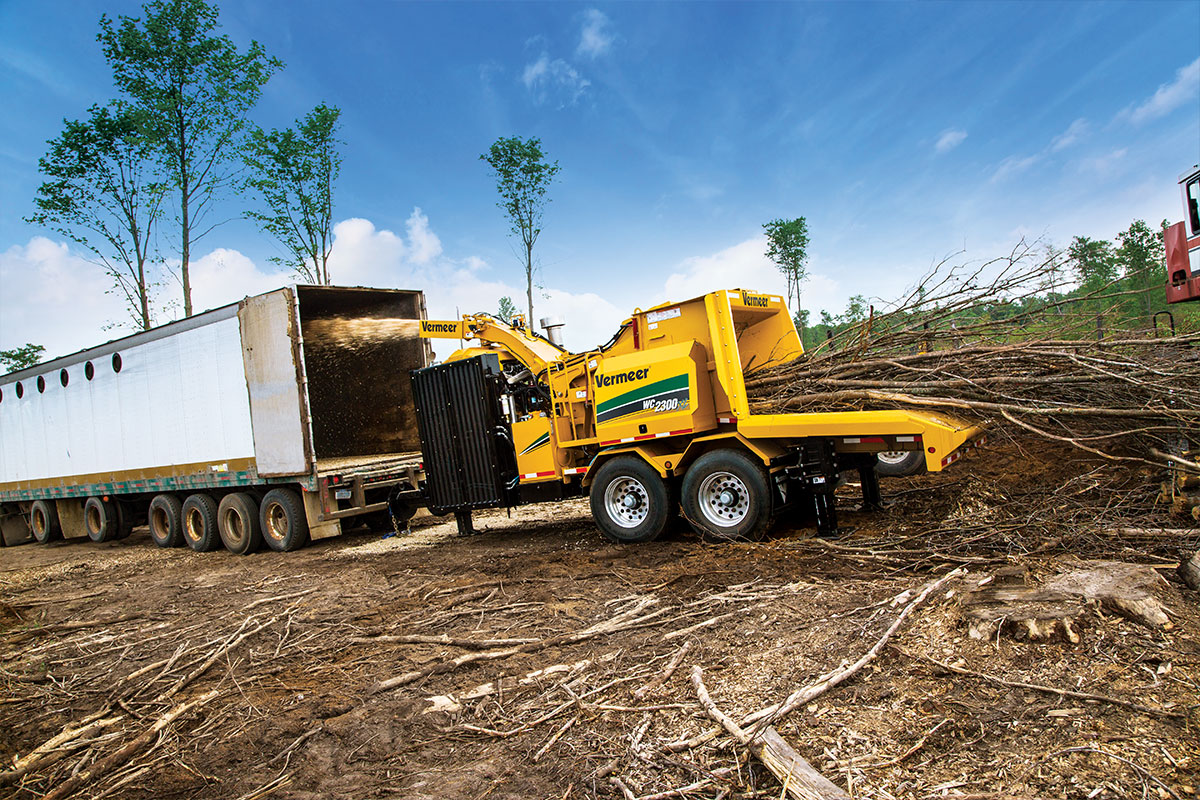Land clearing is a big business and requires the right equipment to process wood waste in an efficient manner. In most cases, contractors have a short window of opportunity to clear the trees, brush and undergrowth from a site in order to make way for the sitework to begin.
Selecting the right equipment is important to help enhance your productivity. There are a number of options available, from large-capacity brush chippers to high-volume horizontal and tub grinders. Each has specific advantages and limitations, depending on the type of work.
Two primary criteria are often crucial when making equipment selection decisions for land clearing operations: mobility and productivity (and the first usually affects the latter). The size of the area being cleared is another key consideration. Brush chippers have traditionally been used in tree-care applications. Now, larger models have made their way into the land-clearing market. For example, if the land being cleared is less than 5-acres, a large towable or self-propelled brush chipper is an option. The larger brush chippers have the ability to process material up to 21 inches (53 centimeters) in diameter, which will address most land- clearing needs.
If the majority of jobs involve 5-acres (2 hectare) or more, a horizontal or tub grinder may be the best option, as they grind greater amounts of material faster. In a situation where a single jobsite may have several debris piles, such as land-clearing jobsite, a self-propelled track-mounted option can be highly efficient.
Selecting the Right Chipper
Mark Rieckhoff, environmental sales manager for Vermeer, says a good rule of thumb is to purchase a chipper that can effectively handle a minimum of 80 to 90 percent of the tree and brush debris a contractor intends to process.
“For example, if a land-clearing contractor plans to process trees where the bulk of the material is 16 to 20 inches (41 to 51 centimeters) in diameter, then a 21-inch (53 centimeters) capacity brush chipper would be sufficient,” says Rieckhoff.
Brush chippers are available in both towable and self-propelled models. Towable chippers have many of the same advantages as self-propelled chippers. However, self-propelled brush chippers have unique benefits on land-clearing jobsites, as contractors realize these units can help reduce labor costs and increase jobsite efficiency.
A contractor may be hired to clear a 1- to 5-acre (.4- to 2-hectare) development site of trees and brush. A self-propelled track chipper allows the contractor to move the machine to the back of the lot and process trees in one pass. This helps avoid the need to cut the trees into smaller, easierto-handle pieces before moving them to the towed chipper, thus reducing saw cuts and labor. In some cases, the developer may want the resulting chips spread evenly on the lot to help control erosion, or left in a pile for landscape mulch once the site is developed.
While track chippers have their advantages, contractors need to think about how these machines can fit into their overall financial and business plan. With a self-propelled track chipper, a contractor may be able to expand into clearing forest undergrowth or utility line clearing.
“The main advantage of a self-propelled track chipper is convenience; however, it’s going to have a higher entry cost than a towed chipper,” Rieckhoff says.
“Contractors should consider how often they are going to use the track chipper, and whether it can open up new markets to their business and help generate a financial benefit.”
When shopping for a track chipper, it is important to select a machine with adequate tractive effort. More specifically, the unit should have track drive torque and power to move on its own, and offer the ability to carry itself uphill and downhill in wet conditions.
In addition, make sure all of the chipper functions work independently. In other words, you should be able to operate the tracks without operating the cutter drum and have the ability to engage the feed rollers without engaging the tracks.
Rieckhoff cautions buyers not to overlook overall features and the quality of the chipper itself.
“Don’t just jump to the tracks,” Rieckhoff says. “A contractor should not sacrifice chipper performance and reliability for tractive effort. The machine needs a good combination of tractive effort, performance and a history of getting the job done.”
Tub Grinders vs. Horizontal Grinders
There are two common types of grinders — tub and horizontal — that are used for land-clearing projects. But there is a method for selection.
“Grinders work best in conditions and applications that match up with their capabilities,” Rieckhoff says. “Tub grinders generally perform better with heavy, large-diameter material such as stumps and root balls. If processing longer raw material is the consistent application, a horizontal grinder may be the best choice.”
For some materials, Rieckhoff says, a tub grinder is perceived to have a higher production rate, but the horizontal models may have a distinct advantage when it comes to the longer, bushier material typically found in land-clearing applications.
“This is mainly because the tub depth is limited, and when processing the longer material, long branches may be difficult to feed. Horizontal models have the long feed table and conveyor that guide material into the grinder, avoiding the sometimes tedious task of material placement and manipulation,” he says.
Also, smaller loading equipment can be used for horizontal grinders, because they typically have a lower feeding height than a tub grinder. This could be a major factor, depending on the auxiliary equipment that an operator has on-site.
Tub and horizontal grinders come with options that are specific to each. For example, Vermeer offers both track-mounted horizontal units and conventional towed models. “Rather than having to tow the machine short distances, it can be moved by the operator, possibly into areas where it could not be towed.”
Vermeer tub grinders, on the other hand, offer both loader and non-loader options.
Among the primary advantages of having a grapple loader on your tub grinder is better visibility of the tub. The loader cab provides better visibility of the tub cavity, so operators can load material more efficiently. Self-contained loaders also eliminate the need for extra pieces of equipment, including a loading unit and the trailer needed to transport it.
Non-loader machines are common on worksites that include a fleet of multi-purpose loading equipment. Some non-loader tub grinders require multiple auxiliary loaders to meet the production capabilities of the machine.
As with any machine, proper preventive maintenance of a grinder benefits its longevity and productivity. Hammers, teeth, hammer shafts, anvils and screens are high-wear items. In the past, some grinder owners have neglected regular maintenance of teeth and hammers, due to the time involved. Vermeer realized this industry issue and addressed it with the introduction of the patented duplex drum system for tub and horizontal grinders. It offers the operator the ability to change out any individual hammer within minutes without removing other hammers. This system makes Vermeer drums more efficient than the conventional “pin-and-plate” drums that have dominated the market.
Grinders on the market range from 100 hp to 1,600 hp (76 kW to 1193 kW). Two things to be considered when selecting a size: the volume and size of material to be processed, and the need for mobility.
Jobsite Safety Considerations
As communities continue to grow, it’s common for land-clearing projects to occur near established commercial or residential developments. That’s why Rieckhoff encourages contractors to consider safety features when selecting a chipper or grinder.
One feature being offered on larger brush chippers and grinders is a radio remote control. The remote control enables a worker to operate the machine from the cab of the loader being used to feed the grinder or from the ground.
It can be argued that with brush chippers, safety features are becoming more important than size and performance. Longer feed tables provide more distance between the cutters and operators. New innovative improvements include an enhanced upper feed control bar with an additional emergency stop position, and the patented Bottom Feed Stop Bar strategically located at the end of the feed table making it possible for the operator’s leg to strike the bar and shut off the feed rollers either intentionally or automatically in an emergency situation.
Over the last several years, Vermeer has designed its tub and horizontal grinders for use in more confined jobsites. One development includes the patented Thrown Object Restraint System (TORS) on tub grinders and the Thrown Object Deflector (TOD) on horizontal grinders, which work to reduce the amount and distance of thrown objects. This allows crews to operate the machines in smaller, space-restricted area.
Don’t Go it Alone
Rieckhoff believes that the most important thing for buyers is to carefully evaluate all the makes, models, sizes, and machine options on the market.
“It’s more possible than ever before for customers to find a brush chipper or grinder that is good match for their type of business, the type of material they’ll consistently chip or grind, the production they require, and the working environment for the machine,” says Rieckhoff.
“Buyers should take advantage of all the research and development that has been done on the manufacturing side… it was done with the intention to benefit them most.”
In the end, a contractor’s ultimate goal should be to purchase a machine that adds value to their business. Rieckhoff says the best advice he can give contractors is to seek the help of a knowledgeable dealer sales staff and dependable service department to identify a reputable manufacturer with quality products. “They’ll help you in making a decision that’s right for your company,” he says.
Once a buyer has determined what’s important and prioritized, the decision between choosing a brush chipper or grinder for your land-clearing business will be much easier.

 MyDealer:
MyDealer:


